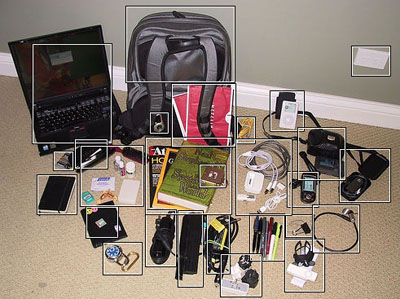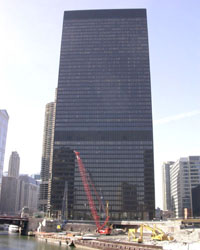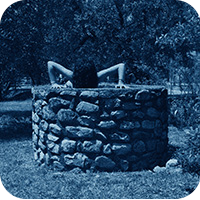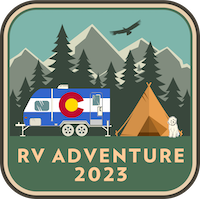Bring it on!
This just in from building management:
One of the noisiest components of the Wabash viaduct reconstruction – metal sheet pile driving as part of the caisson installation – is scheduled to begin on Thursday, March 17, 2005. This activity may also cause the building to vibrate.
They’ve never warned of vibration before and this place certainly shook when they were ripping apart Wabash. I wonder if this is an attempt to proactively warn or if they really mean the Richter scale is going to be involved here.
The test will be if the building shakes enough to park the hard drive head of my ThinkPad. Sorry, boss, gotta go home, my hard drive airbag just deployed.
UPDATE (3/18): No piles driven, no buildings shaken, no airbags deployed. So very anticlimactic!
Stuff in my backpack, international edition
Today I booked four separate itineraries in three countries for travel before the end of May. Really the only way to manage such a schedule is to have the right gear. Jumping on the whatsinyourbag tagfest over at Flickr I have catalogued all those things that keep me sane and connected when I travel — in this case internationally. Bag contents differ slightly for the commute to work and for domestic travel.
(These inventory spreads remind me of a dated little travel book called Point It. For the international tourist who has absolutely no desire to learn any new terms whatsoever.)
So, what am I missing?
Is there anything cover art can’t do?

Continuing the recent themes of cover art and interesting uses of web services and open API’s (in the marginalia sidebar), here’s AmazType, a creative little app that creates a word-mosaic of your search term from the covers of books and music at Amazon that are related to the term. So, “Shakespeare” would return that word created from the covers of all the books containing his works.
I consider this a perfect use of technology.
ScrobbleViz

Audioscrobbler continues to amaze me. Profiling your listening tastes and creating a personal stream from that profile is cool, sure, but you soon crave a visualization of the network of relationships that your taste is at the center of. Enter the TouchGraph app for Audioscrobbler. It is pretty basic, plotting relationship maps of artists based on the same algorithm that computes your musical “neighbors.” But you could easily see a more generic app that could take your Audioscrobbler XML feed and continually morph the map (like the Eternal Egypt screensaver, blogged yesterday, does). Clicking on any node might take you directly to a stream of that artist (or the iTunes store). Or maybe there’s an integration point with the attractive (and more info-dense) LivePlasma.
My current thought-exercise, though, is what to do with the links between the music nodes. How could you sonify them? What does the musical connection between, say, Johnny Cash and Cake sound like?
See also: In the gutter
Museums and the Web 2005
I’ll be presenting at this year’s Museums and the Web conference in Vancouver, April 13-16. If you’re going to be there (or live in Vancouver) and want to meet up, drop me a line. Five years ago one of my projects won the Best of the Web award here. Here’s hoping Eternal Egypt can regain the honor amongst such worthy competition.
Eternally yours
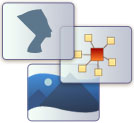
The Eternal Egypt project — long my primary focus at work — has just released a screensaver for PC. It is actually a functional app, cycling between three separate modes. It will run a loop similar to the splash screen on the website and will download images randomly from the site (with a running history and ability to send an e-card). My favorite, though, is the mode where it continuously traverses the spatialized relationship web known as Connections. You can do so manually straight from the screensaver too. Have fun!
Fantasy and reality
Baseball season’s almost here and that means fantasy leagues are gearing up. Steroid usage is all the talk too with fans on the slippery slope of a debate over what constitutes “real” athleticism. (Steven Johnson predicts that elective surgery is the next category of performance enhancement.) Meanwhile, more entertainment dollars are spent on computer games than attending actual sporting events. (And who knows how much more is spent gambling on sports — a meta-sporting activity, so to speak — than on the sport directly.) Hard to know the boundaries of the real sport.
What I’d like to see is an application that merges an online fantasy basball league, a sports-action baseball game, and a Sim Baseball-type universe (such as this). This way you could field your actual fantasy team (using current or past players) and, using the rich data of past performance, play out actual games at any level from just watching stats crunch against each other spreadsheet-macro-like to actually trying to make Aramis Ramirez hit a pitch from, say, Pedro Martinez. Then, layer in the Sim component (based on as much data as can be mined) to allow you to operate the virtual club and individual players as fully as possible. Salary caps, personality/compatibility issues, performance-enhancing drugs — you’d decide all of this. Or, at least let the data-rich simulation run its course based on a few parameters you set. For example, what would happen if everyone in the league was on androstenedione?
Maybe this kind of app already exists. Seems like it would be hellishly complex, though.
The real question is: how soon until the virtual derivatives of sport feed back into the sport itself? (Not counting gambling scandals, that is.) It happens in other forms of entertainment all the time. How long before there is a game that pits the actual human players of the two best fantasy teams — or some computer-modelled aggregate of the best fantasy teams at any given moment — in the world against each other?
Networks and lines
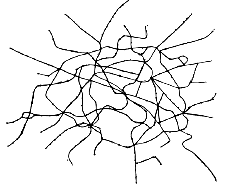
Abstracted map of the Paris metro
I have been thinking about networks since Craig’s thought-provoking comment about the radial nature Chicago L system a few days ago. Thing is, I can’t shake the feeling that narrative and transportation networks are somehow related.
One easy relationship has to do with consumption. I enjoy being on the subway because it affords me time to read that I otherwise would not have. (I turn down rides home because I crave the time to read on the subway.) But what I really love is the way the L — especially when it is underground and impervious to cell transmission — eliminates options. You may be late for work, but there’s really nothing you can do about it. You can’t call anyone; you can’t get off the train and get to work any faster; you’re stuck. And that is wonderful. I feel like I suffer from a surfeit of options sometimes. It is so nice to just resign yourself to the moment. I’m going to keep reading until my stop, damnit. So nice to succumb to linearity.
But that’s not really what interests me. I’m still trying to tease this out, but clearly subway system design has conceptual similarities with new media. Stories can be point-to-point, multi-linear, radial, and true networks. They can even break out of the established route, creating new stations further afield. If you mapped these narrative arcs I bet they would bear a striking resemblance to the abstracted maps of subways around the world.
The final timelapse
Video stitcher extraordinaire Jack Blanchard delivers this last timelapse (WMV, 10MB) of our officecam Sun-Times deathwatch. Now with music!
Meanwhile, A Daily Dose of Architecture presents a photographic homage to my building, newly — and temporarily — presenting a stunning view from the Michigan Ave. bridge thanks to the demolition.
Is that straight out of 2001: A Space Odyssey or what?
Word problem, the riveting conclusion
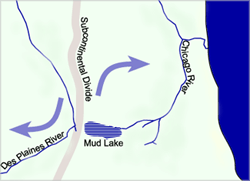
A follow-up to my previous post about water drainage on Harlem Ave. It was, of course, a trick question. At least one of you suggested as much, though no one actually got the answer right. You see, Harlem Ave. is the rough location of a miniature continental divide. Water to the west of Harlem flows west; drainage east goes east. What took me a while to realize is that there still is only one Continental Divide. Drainage west of Harlem doesn’t keep flowing west. Eventually it dumps into the Mississippi and thence to the Gulf. Going the other way ends up in the Lake or the Atlantic. So the answer, assuming no sewer craziness, is that the hydrant run-off will end up in the Gulf.
The Chicago Public Library explains this a bit better. Among other things, this divide is what made the area so attractive to early explorers. A short portage and you could be headed to the Mississippi or the Great Lakes. (Before the Chicago River was reversed, that is.)
Oh, by the way, that little traffic incident didn’t really happen. Just a story in the service of the contest. But thanks for the concern!

